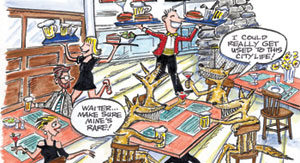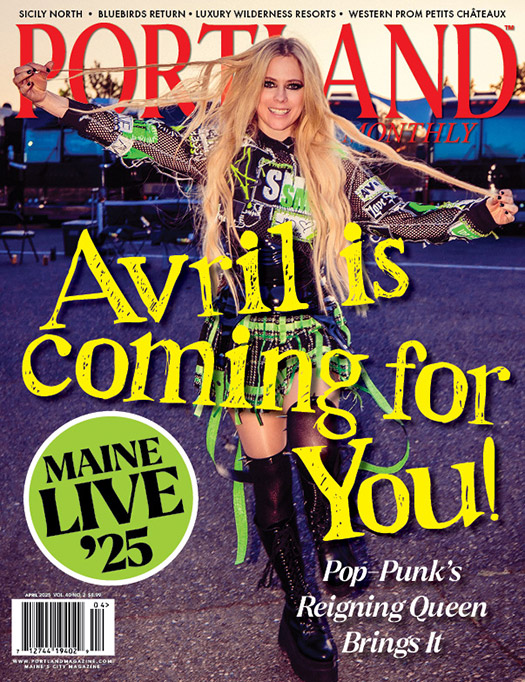April 2018 | view this story as a .pdf
Take a walk through the urban forest with your wild neighbor, the eastern coyote.
By Sarah Moore
 One evening in May 2015, Belinda Erskine was sitting down to dinner with her family in Cape Elizabeth when she spotted something moving in the yard through the living-room window. “It was small and fluffy. At first, I thought it was a kitten.” Erskine went out to get a closer look. The creature was small enough to fit in her hand. “I sent a picture to my brother-in-law. Then he asked for a shot of the paw. That’s how we figured out it was canine and not a kitten.”
One evening in May 2015, Belinda Erskine was sitting down to dinner with her family in Cape Elizabeth when she spotted something moving in the yard through the living-room window. “It was small and fluffy. At first, I thought it was a kitten.” Erskine went out to get a closer look. The creature was small enough to fit in her hand. “I sent a picture to my brother-in-law. Then he asked for a shot of the paw. That’s how we figured out it was canine and not a kitten.”
At a loss, Erskine called the animal wardens who service South Portland and the Cape Elizabeth area, which includes “Cape Elizabeth Land Trust and a lot of wildlife,” she says. “They told me to leave the pup outside.” Erskine, reluctant to forsake her to the cold night, “brought her indoors, wrapped her in a blanket, and placed her in a box on the kitchen table.” The next day, animal control officer Corey Hamilton and local game wardens transferred her to a rehabilitation clinic. Hamilton believes the foundling was either a baby coyote or gray fox. And while it came as no shock to Erskine that she shares her yard with a host of non-human residents–“There are coyotes all around here. I see them lounging on the picnic tables at Kettle Cove Take Out & Dairy opposite my house”– the experience illuminates how closely she truly cohabits with her wild neighbors.
“While most of us are familiar with squirrels, raccoons, and the odd opossum, few know that the Portland area–especially the urban fringe–also plays home to critters like striped skunks, foxes, minks, otters, fishers, and larger carnivores such as bobcats and the eastern coyote,” says Dan Gardoqui, founder of White Pines Program, an organization that aims to increase education and engagement with the natural world.
“We’ve had coyotes, bear, and moose all spotted within half a mile of the Casco Bay Bridge,” Hamilton adds. “I get a large number of calls simply because someone’s spotted something they think shouldn’t be living around humans. This is Maine; we have lots of wildlife. These animals were living here long before houses were built in their habitat.”
While we might thrill at the sight of bears and bobcats, the common coyote is derided as a more prosaic and verminous type of hunter. Have we simply been programmed to mistrust the canny canine?
“The coyote is an American original,” says Dan Flores, author of Coyote America, in which he explores how the creature became the victim of a negative PR campaign in the early 19th century. Flores calls out government agencies and even Mark Twain, for his 1870 travel book Roughing It, as culprits in the anti-coyote regime. Despite this, the coyote has proven to be one of the nation’s most enduring and adaptable icons, now inhabiting every state except Hawaii. “[Its howl] is our original national anthem.”
Wile E. Coyote, perhaps we’ve been looking at you all wrong.
God’s Dog
“Similarly to tigers living in cities in India, coyotes in urban areas find small green spaces to live and reproduce, coming out at night when we’re in bed,” says conservation biologist Geri Vistein, founder of coyotelivesinmaine.com. But Vistein is quick to point out the canis latrans is no urban interloper. Coyoti is an ancient creature, named by the Aztecs and revered as a trickster god in Native American mythology. “The coyote has been here since the first people crossed the Bering Sea into the Americas,” she says. “In fact, archaeologists have found coyote bones in New England from 30,000 years ago–predating the Ice Age.”
Until the early 19th century, Maine’s mountains and dense forests were the kingdom of the gray wolf, while coyote territory mainly stretched west from Illinois to the Rocky Mountains. When human predation decimated the two million-strong national gray wolf population, there left a gap for the infinitely adaptable coyote to make its return to New England, bringing with it a whisker of its lupine cousin. “Canada didn’t destroy its wolf population to the same extent we did,” Vistein says. “As a result, some of the few remaining males wolves in the Ontario region mated with coyotes. You can see this in the larger jaw muscles that allow them to take down larger prey. Our coyotes carry a mix of wolf genes, but they are coyote, coyote, coyote. The wonder and wisdom of nature saw a space to fill, allowing the species to adapt and survive.” This innate knack for survival in a changing world has seen the coyote flourish where others like the gray wolf have fallen. Vistein emphasizes the animal’s intelligence, too. “Coyotes used to have relatively harmonious relationship with Native American tribes. They knew where people were, rodents would be. I work with a farmer in Maine who, during the summer haying season, will start up his tractor at night and see the coyotes appear like clockwork in his headlights, waiting for the machine to flush animals out of the dry grass.”
In the Neighborhood
For those of us living in the comfortable cushion of urban and suburban communities, stepping out at night in our slippers, perhaps, to put out the garbage or sneak a surreptitious smoke, the flash of a pair of wild eyes can send a jolting moment of primitive fear through our bodies–a quick blast of Freud’s Uncanny. National organizations like Project Coyote and Urban Coyote Initiative aim to redress the hostility felt toward the beasts living in the margins of our cities. “By eliminating natural predators and natural barriers of habitat, humans have literally paved the way for coyotes to explore new territories, including the prairies of suburban lawns and the forests of skyscrapers in cities,” reads the mission statement on Urban Coyote Initiative’s webpage.
The reasons for wildlife residing and reproducing in places like Portland are “complex,” according to Gardoqui. “Chances are, the abundant food resources are a big draw. Cities have a lot of ‘live’ foods like squirrels, mice, birds, and rats as well as a some ‘non-live’ food sources wasted by humans,“ he says. These appear particularly delicious to coyotes in April, when male and female pairs are raising litters of pups. However, they’re a lot less likely to grab a quick takeout from your garbage than a raccoon. An Urban Coyote Initiative study of over 1,400 subjects showed coyotes supplement their diet with only 1.3 percent of our discarded lettuce heads and diet shakes.
As for any threat to us and our beloved Fido and Felix, “The risk of humans or their pets being harmed by wild coyotes is very, very slim,” Gardoqui assures. There has only been one reported human fatality caused by a coyote attack, in 1981. When it comes to our fluffy family members, awareness is key. “I’ve seen how pet owners have become a lot more responsible in the 27 years I’ve lived in Maine,” Vistein says. “But we need to remember, if you leave your little five-pound toy dog in the yard at night time…Well, to a coyote, that’s no dog, that’s dinner! The same goes with cats. We tend to let our feline pets roam in urban areas, but that’s a potential dinner for a coyote.” During pup season, dogs are as likely to threaten coyotes by interfering with their dens and stressing the mother and babies. “Keep your dog on a leash or in sight of you,” Vistein urges. As for those bird feeders you lovingly hang in hopes of the scarlet glimpse of a cardinal? “Take them down,” she says. “It goes against what we’ve been taught, but more seeds on the ground means more rodents. You’re inviting coyotes right into your yard.” Though our kinder nature may tempt us to leave out snacks for furry and feathered friends, “It’s not a natural part of the ecosystem.” The same goes for intentionally leaving out food for coyotes themselves. “Those species have survived the winter without us for millennia.”
When left to their own devices, coyotes control rodent populations–a boon in our litter-strewn urban areas. They’ll also deter felines, allowing bird populations to flourish. And while these adaptable and fiercely intelligent creatures have learned to live among humans, we’re still learning how to coexist with them. “They don’t want to interact with humans in the vast majority of instances,” says Dan Gardoqui, “mostly because when wild animals and humans tangle, it usually doesn’t end up well for the animal.”





0 Comments